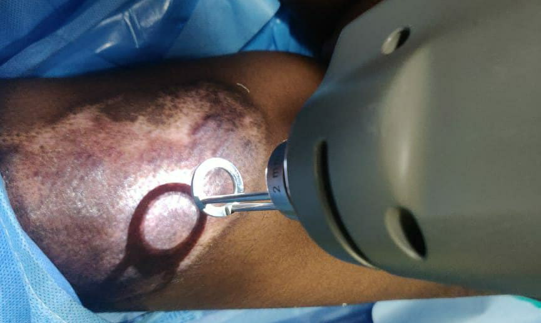Introduction
Erbium YAG lasers are devices in which the active ion in a matrix like YAG is the rare earth element Erbium (yttrium aluminium garnet). Human skin can be resurfaced using erbium YAG lasers with a wavelength of 2.9 m to cure melasma, deep rhytides, and acne scars. The Erbium YAG laser, which has a wavelength of 2940 nm and a strong absorption in water, can be used to precisely and superficially ablate tissue since it almost completely absorbs in a very thin layer of skin beneath the surface.1, 2, 3 The donor areas for skin grafting typically heal by secondary intention, leaving a scar there. A innovative method to the treatment of scars is the use of ablative lasers based on the fractional approach.4, 5 This study highlights the role of Erbium YAG laser for the management of scar at the donor site of skin grafting.
Materials and Methods
The study was conducted in the department of plastic surgery in a tertiary care hospital. Informed consent was obtained from the subject under study. Scientific and ethical approval was taken from department scientific and ethical committee. The patient being reported is a 7 year female child who presented with history of accidental spillage of hot water soup on her while playing in the kitchen involving the chest, abdomen, axilla, left upper arm and forearm amounting to a total of about 20 % mixed 2nd degree and 3rd degree deep burns. Patient complains of severe burning, itching and pain. The patient was admitted and treated initially with intra venous fluids and sterile dressing. After 48 hours tangential excision and skin grafting was done. The donor site of skin grafting (thigh) healed in 3 weeks. To prevent abnormal scaring at the donor site of skin grafting, 6 sessions of Erbium YAG laser were given at 3 weeks interval (Figure 1). Before and after session of Erbium YAG laser the photographic documentation of donor site was done.
The laser machine used was Quanta Q1TM laser with the Twain handle delivering at 2940 nm wavelength laser after taking necessary safety precautions. We used 4 mm tip with a pulse width of 0.3 J/cm2 and a fluence of 4. The overall procedure takes 20 to 25 minutes and the patient tolerated the procedure well. After the procedure the site was cooled for 5 minutes. The patient was advised to avoid direct sunlight exposure and to use sunscreen with >30 SPF. The patient was given regular 6 sessions at 3 weeks interval. There were no adverse effects noted except for post treatment initial erythema which resolved within 5 to 7 days spontaneously. Laser treatment was given on outpatient basis and patient was allowed to continue with activities of daily life.
Results
After a follow up period of 5 months no adverse effects were noted. The scar remained soft and supple and did not develop any abnormal scaring.
Discussion
A hypertrophic scar is a condition marked by fibrosis and disorganized skin fibroblast collagen deposition.6 Gender, age, genetic predisposition, patient immunological responses, kind of damage, wound size and depth, anatomical placement, and mechanical tension on the wound are six major risk factors for the development of hypertrophic scars.7 The imbalance between Extra Cellular Matrix (ECM) synthesis and breakdown during wound healing is thought to be the cause of hypertrophic scar development.8 Scar management techniques include the use of silicone sheets, pressure garments, steroids, resection and radiation, and various botulinum toxin types. There isn't a single method that can effectively remove all scars. Recently, it was discovered that carbon dioxide and the Erbium YAG laser are secure and reliable scar control techniques.9, 10
Clinically, it is commonly acknowledged that pulsed dye laser (PDL) therapy minimises the production of hypertrophic scars primarily by reducing angiogenesis. According to reports, PDL increases the pliability and erythema of young scars by photothermolyzing tiny blood vessels.11 Other hypotheses for the process by which PDL can be clinically effective in treating scars include decreased cellular activity brought on by laser-induced anoxia or collagen lysis brought on by laser-stimulated cytokine release.12 Although CO2 lasers have traditionally been used to treat scars, Erbium YAG lasers offer all the advantages, including effective and precise tissue ablation. The use of the 2940 mm Erbium YAG laser prevents the potential of heat necrosis and enables more precise tissue ablation because its depth of penetration is just one sixth that of CO2 lasers.13 The lack of need for recipient site anaesthetic due to little to no pain is one special benefit of employing the Erbium YAG laser.14 Thus, the Erbium YAG laser provides the operator with convenience and also creates a reasonably blood-free environment for the specialist's easier surgery.
Other treatments, like as silicone sheets and compression clothing, are pricy and difficult to apply. The patient had to visit the hospital frequently for the laser therapy, though, which was a drawback.15 In our study, Erbium YAG laser was found to be useful in preventing abnormal scaring at the donor site skin grafting. The limitation of the study is that it is based on single case. A large multicentric, randomized, controlled trials are suggested to substantiate the outcome of our study.


